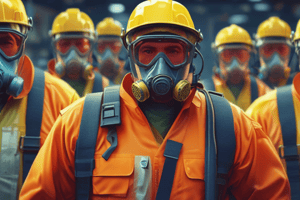Podcast
Questions and Answers
Who is responsible for purchasing PPE?
Who is responsible for purchasing PPE?
Employers
Which PPE is exempted from employer purchase?
Which PPE is exempted from employer purchase?
Safety shoes
What is the first thing an employer must do to determine what PPE is required for a job?
What is the first thing an employer must do to determine what PPE is required for a job?
Job hazard assessment (JHA)
List and describe the 3 classifications of hard hats.
List and describe the 3 classifications of hard hats.
What is the 'safety zone' of a hard hat and how big must it be?
What is the 'safety zone' of a hard hat and how big must it be?
What training on hard hats must employees undergo?
What training on hard hats must employees undergo?
What are the requirements for eye protection?
What are the requirements for eye protection?
How is the Noise Reduction Rating (NRR) used when assessing hearing protection?
How is the Noise Reduction Rating (NRR) used when assessing hearing protection?
What training must be provided regarding hearing protection?
What training must be provided regarding hearing protection?
When might respirators be required?
When might respirators be required?
What are the 4 types of respirators and how do they work?
What are the 4 types of respirators and how do they work?
What are qualitative and quantitative fit tests?
What are qualitative and quantitative fit tests?
What are the components of a Respiratory Protection Program?
What are the components of a Respiratory Protection Program?
What training must be given on respirators and how often?
What training must be given on respirators and how often?
Flashcards are hidden until you start studying
Study Notes
Personal Protective Equipment (PPE) Overview
- Employers are responsible for procuring PPE for their workers.
- Safety shoes are exempt from employer obligations regarding PPE procurement.
Job Hazard Assessment
- A job hazard assessment (JHA, SRA, etc.) must be conducted to identify necessary PPE.
- The employer is required to maintain a copy of the JHA for reference.
Hard Hat Classifications
- Class E: Electrical helmets tested for protection up to 20,000 volts.
- Class G: General helmets tested for low voltage protection at 2,200 volts.
- Class C: Conductive helmets that lack any electrical protective testing.
Hard Hat Safety Zone
- The safety zone is the gap between the hard hat's suspension and outer shell, which absorbs impacts.
- A minimum distance of 1 inch is mandated for the safety zone.
Hard Hat Training Requirements
- Employees must learn the necessity of head protection, limitations, and proper usage of hard hats.
- Training includes instruction on checking and inspecting hard hats.
Eye Protection Requirements
- Eye protection must adequately shield against specific hazards and be comfortable to wear.
- Fit should be snug without obstructing vision, and it must be durable and easy to clean.
Hearing Protection and Noise Reduction Rating (NRR)
- To assess hearing protection: subtract the C-weighted Time-Weighted Average from the NRR or adjust an A-weighted dose by subtracting 7 dB from the NRR.
Training on Hearing Protection
- Training must cover effects of noise, use of hearing protectors, and their advantages and disadvantages, along with care instructions.
Situations Requiring Respirators
- Respirators are required when exposure exceeds permissible limits or when engineering controls are unfeasible.
- They are essential in regulated areas and emergencies.
Types of Respirators
- Air-purifying respirators filter contaminated air through media.
- Powered air-purifying respirators enhance filtration with a blower.
- Self-contained breathing apparatuses supply air from a closed system.
- Supplied-air respirators provide fresh air through an air line.
Fit Testing for Respirators
- Qualitative fit tests determine respirator adequacy based on user response to irritants or odors.
- Quantitative fit tests measure the actual leakage into the respirator.
Respiratory Protection Program Components
- A comprehensive program includes selection procedures, medical evaluations, fit testing, usage instructions, maintenance schedules, and training requirements.
Respirator Training Requirements
- Training covers the necessity and limitations of respirators, inspection, maintenance, cleaning, and proper usage.
- Annual training sessions are mandated for employees using respirators.
Studying That Suits You
Use AI to generate personalized quizzes and flashcards to suit your learning preferences.




